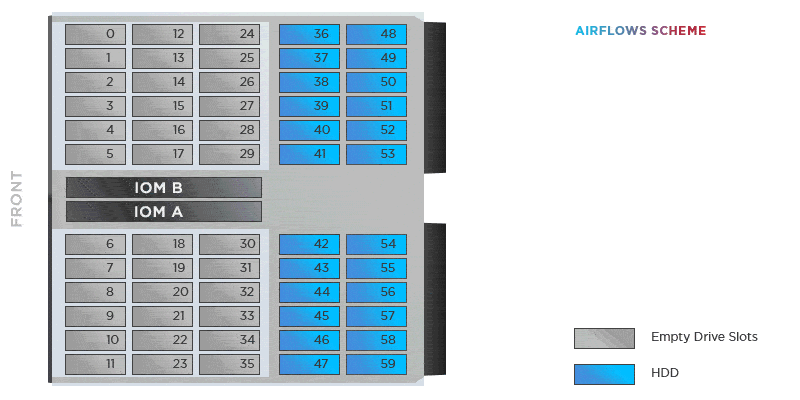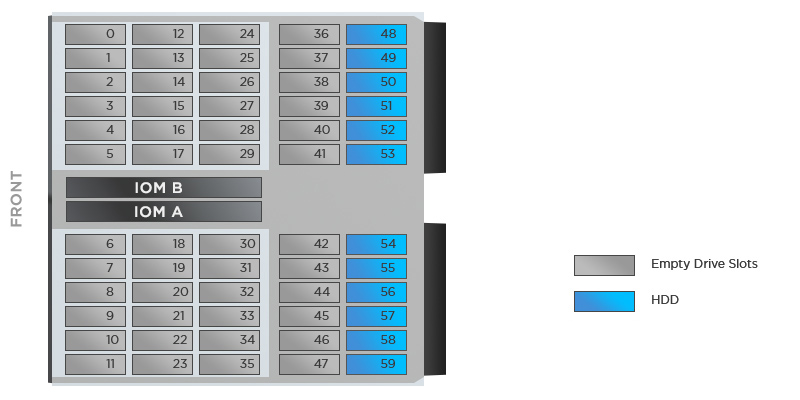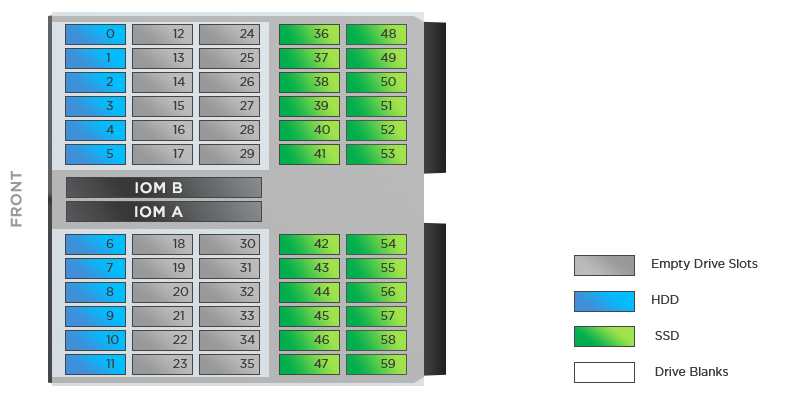JBOD modular storage and degrees of freedom
When a business operates with bulk data, the storage unit becomes not a separate disk, but a set of disks, their totality, an aggregate of the required volume. And it should be managed as a whole entity. The logic of scaling storage of large-block aggregates is well described by the example of JBOD - as a format for combining disks and as a physical device.
You can scale disk infrastructure not only “upwards” by cascading JBOD, but also “inwards”, using various filling scenarios. How it works, consider the example of Western Digital Ultastar Data60.
JBOD is a separate class of server hardware for dense disk placement, with multichannel access to them by control hosts via SAS. JBOD manufacturers sell them empty, partially or completely clogged disks - who like. The gradual filling of the repositories with disks - as the needs grow - allows the capital costs to be spread over time. At Western Digital it is profitable to buy JBOD with all 60 discs - so much cheaper. But you can take and partially filled: the minimum equipment Ultastar Data60 is 24 drives.
')
Why 24? The answer is simple: aerodynamics. The JBOD 4U / 60 x 3.5 ”Gold Standard has taken root in the industry for practical reasons — reasonable device size, access, good cooling. 60 discs are recruited as 5 rows of 12 HDD each. Partial filling of rows or a shortage of disks in JBOD (for example, only one row) leads to a deterioration of heat removal or even to reverse the air flow in the central channel - a design feature of Ultastar Data60, its distinctive feature.
In its JBOD, WD uses ArcticFlow disc blowing technology, carefully modeled and verified. All for HDD - for their performance, survivability, data integrity.
The essence of the ArcticFlow is reduced to the formation of two independent air streams with the help of fans: the frontal cools the front rows of the drives, and the air entering through the internal air corridor into the depths of the case is used to blow discs in the back zone of the JBOD.
It is clear why for the efficient operation of the ArcticFlow it is necessary to monitor the filling of free compartments. In the minimum configuration of 24 disks, the placement in Ultastar Data60 must start from the rear zone.

In a configuration of 12 drives, without encountering the resistance that the two-row layout should create, the air flow at the outlet of the JBOD again passes through the frontal zone into the cooling system.

There is a way to improve the situation - about him further.
It should immediately be taken as an axiom that the purpose of JBOD is in scaled data storage. From this conclusion: use it for a population of homogeneous devices. With a sight - with time to reach the design storage volume, filling all the compartments.
But what about SSD? The best (and right) solution is to build a separate productive repository on JBOF. Solid there more comfortable. However, Ultastar Data60 allows installation and flash drives. Before embarking on JBOD hybridization, you should first weigh the pros - choose an SSD from the list of compatible ones (as opposed to HDD, the situation with SSD support is full of nuances). You will also have to spend money on mounting 2.5-inch disks in 3.5-inch compartments.
Single SSD devices should be positioned in the rear zone of the JBOD, closing the unused compartments with special plugs - Drive Blanks. This blocks the free flow of cooling air, as mentioned above, to prevent its recirculation.

In total, no more than 24 SSDs are allowed in the Ultastar Data60 chassis. In any case, it should be the last rows of the rear zone.

Why 24? Heat dissipation of solid-state drives is higher than similar characteristics of the HDD, for this reason the multi-row layout of disks with different types of media will not be blown effectively by ArcticFlow. And heat removal will be a risk factor for the operation of JBOD.
It is appropriate to note here that using Drive Blanks you can reduce the effect of hot air recirculation. A JBOD layout with 12 HDDs will cool better if you close the empty compartments with plugs. The manufacturer did not say a word about such a trick, but the right to experiment is always with us. By the way, WD does not prohibit 12-disk filling, although it does not recommend it.
Even a superficial acquaintance with the aerodynamics of JBOD gives an idea that for reliable operation of the repository it is better to rely on the experience and recommendations of the developer. The processes occurring inside the disk basket require basic research. Neglecting the knowledge gained is fraught with problems that, in storage volumes of hundreds of terabytes, are sensitive in every sense.
It is known how troop regulations are written. Something similar happens with the JBOD architecture. If the solutions of the recent past have been committed by the layout, in which the interface part was in the “exhaust” zone blown by hot air, then today Ultastar Data60 is deprived of this disadvantage. All other design finds are just a technological marvel. So to this and should be treated.
You can scale disk infrastructure not only “upwards” by cascading JBOD, but also “inwards”, using various filling scenarios. How it works, consider the example of Western Digital Ultastar Data60.
About filling
JBOD is a separate class of server hardware for dense disk placement, with multichannel access to them by control hosts via SAS. JBOD manufacturers sell them empty, partially or completely clogged disks - who like. The gradual filling of the repositories with disks - as the needs grow - allows the capital costs to be spread over time. At Western Digital it is profitable to buy JBOD with all 60 discs - so much cheaper. But you can take and partially filled: the minimum equipment Ultastar Data60 is 24 drives.
')
Why 24? The answer is simple: aerodynamics. The JBOD 4U / 60 x 3.5 ”Gold Standard has taken root in the industry for practical reasons — reasonable device size, access, good cooling. 60 discs are recruited as 5 rows of 12 HDD each. Partial filling of rows or a shortage of disks in JBOD (for example, only one row) leads to a deterioration of heat removal or even to reverse the air flow in the central channel - a design feature of Ultastar Data60, its distinctive feature.
In its JBOD, WD uses ArcticFlow disc blowing technology, carefully modeled and verified. All for HDD - for their performance, survivability, data integrity.
The essence of the ArcticFlow is reduced to the formation of two independent air streams with the help of fans: the frontal cools the front rows of the drives, and the air entering through the internal air corridor into the depths of the case is used to blow discs in the back zone of the JBOD.
It is clear why for the efficient operation of the ArcticFlow it is necessary to monitor the filling of free compartments. In the minimum configuration of 24 disks, the placement in Ultastar Data60 must start from the rear zone.

In a configuration of 12 drives, without encountering the resistance that the two-row layout should create, the air flow at the outlet of the JBOD again passes through the frontal zone into the cooling system.

There is a way to improve the situation - about him further.
About hybrid
It should immediately be taken as an axiom that the purpose of JBOD is in scaled data storage. From this conclusion: use it for a population of homogeneous devices. With a sight - with time to reach the design storage volume, filling all the compartments.
But what about SSD? The best (and right) solution is to build a separate productive repository on JBOF. Solid there more comfortable. However, Ultastar Data60 allows installation and flash drives. Before embarking on JBOD hybridization, you should first weigh the pros - choose an SSD from the list of compatible ones (as opposed to HDD, the situation with SSD support is full of nuances). You will also have to spend money on mounting 2.5-inch disks in 3.5-inch compartments.
Single SSD devices should be positioned in the rear zone of the JBOD, closing the unused compartments with special plugs - Drive Blanks. This blocks the free flow of cooling air, as mentioned above, to prevent its recirculation.

In total, no more than 24 SSDs are allowed in the Ultastar Data60 chassis. In any case, it should be the last rows of the rear zone.

Why 24? Heat dissipation of solid-state drives is higher than similar characteristics of the HDD, for this reason the multi-row layout of disks with different types of media will not be blown effectively by ArcticFlow. And heat removal will be a risk factor for the operation of JBOD.
It is appropriate to note here that using Drive Blanks you can reduce the effect of hot air recirculation. A JBOD layout with 12 HDDs will cool better if you close the empty compartments with plugs. The manufacturer did not say a word about such a trick, but the right to experiment is always with us. By the way, WD does not prohibit 12-disk filling, although it does not recommend it.
Practical conclusions
Even a superficial acquaintance with the aerodynamics of JBOD gives an idea that for reliable operation of the repository it is better to rely on the experience and recommendations of the developer. The processes occurring inside the disk basket require basic research. Neglecting the knowledge gained is fraught with problems that, in storage volumes of hundreds of terabytes, are sensitive in every sense.
It is known how troop regulations are written. Something similar happens with the JBOD architecture. If the solutions of the recent past have been committed by the layout, in which the interface part was in the “exhaust” zone blown by hot air, then today Ultastar Data60 is deprived of this disadvantage. All other design finds are just a technological marvel. So to this and should be treated.
Source: https://habr.com/ru/post/446694/
All Articles